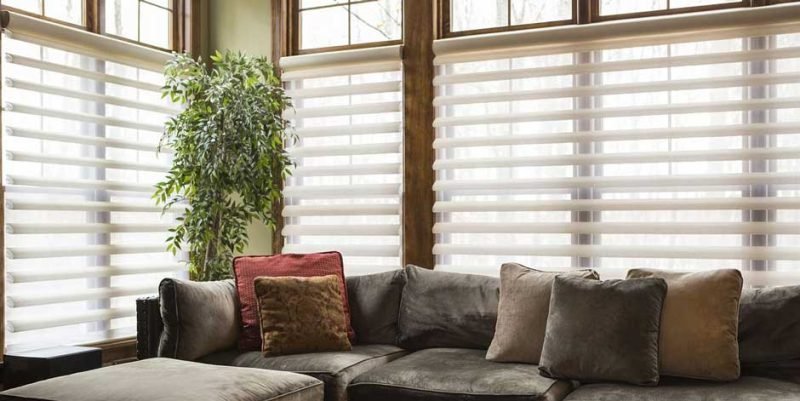
Are you tired of the same old curtains and drapes? Are you looking for a functional and fashionable window treatment option? Look no further than blinds! In this blog post, we’ll explore the benefits and different types of blinds available, as well as provide some tips for choosing the best blinds for your home and Hampton Bay Blinds, so lets ge started!
What Are Blinds?
Blinds are a type of window treatment made up of horizontal or vertical slats that can be opened or closed to control the amount of light and privacy in a room. They can be made from a variety of materials, including wood, metal, and plastic, and come in a range of colors and styles to suit any decor.
Benefits of Blinds
There are many benefits to choosing blinds as your window treatment solution. Here are just a few:
- Control: Blinds allow you to easily control the amount of light and privacy in a room by simply adjusting the slats.
- Energy efficiency: Certain types of blinds, such as cellular or honeycomb blinds, are designed to help insulate your windows and reduce heat loss in the winter and heat gain in the summer. This can help save on energy costs and make your home more comfortable year-round.
- Durability: Blinds are a long-lasting and low-maintenance window treatment option. They are easy to clean and can withstand everyday wear and tear.
- Style: Blinds come in a wide range of styles and materials, so you can choose the perfect look for your home. From traditional wood blinds to modern metal blinds, there is a style to suit every decor.
Types of Blinds
There are several different types of blinds to choose from, each with their own unique features and benefits. Here is a brief overview of some of the most popular options:
- Venetian blinds: These blinds are made up of horizontal slats that can be tilted to control the amount of light and privacy. They are available in a variety of materials, including wood, metal, and plastic, and come in a range of colors and finishes.
- Roman blinds: Roman blinds are made of fabric and fold up into neat pleats when raised. They provide a more elegant and sophisticated look than some other types of blinds and are a great choice for formal spaces.
- Roller blinds: Roller blinds are a simple and affordable option made of a single piece of fabric that rolls up or down to cover the window. They are easy to operate and work well in any room.
- Cellular or honeycomb blinds: As mentioned earlier, cellular blinds are designed to be energy efficient. They are made up of a series of interconnected cells that trap air and create a barrier between the window and the room, helping to insulate the space.
Choosing the Right Blinds
When it comes to choosing the right blinds for your home, there are a few things to consider:
- Functionality: Think about the primary function of the blinds. Do you need to block out a lot of light? Do you need privacy? Different types of blinds excel at different things, so it’s important to choose the right type for your needs.
- Style: Blinds come in a range of styles and materials, so you can choose the look that best fits your decor. Consider the overall style of your home and choose blinds that complement it.
- Size: Measure your windows accurately to ensure that you get the right size blinds. Blinds that are too small won’t provide adequate coverage, while blinds that are too large may not fit in the window frame properly.
- Material: The material of your blinds can affect both the look and functionality of your window treatment. Wood blinds are a classic and stylish choice, but they may not be the best option for humid environments as they can warp over time. Metal blinds are durable and easy to clean, but they may not provide as much insulation as other materials. Fabric blinds can add a softer and more luxurious touch, but they may not be as durable as other options.
- Color: Choose a color that complements your decor and enhances the overall look of your room. If you have a lot of patterned fabrics or bold colors in your space, it may be best to choose a neutral color for your blinds to avoid overwhelming the room. On the other hand, if you have a more neutral palette, you may want to add some color with your blinds.
- Operation: Consider the ease of operation when choosing your blinds. Some types, like Venetian blinds, require manual adjustment of each slat, while others, like roller blinds, can be raised and lowered with a single pull cord. If you have large windows or hard-to-reach areas, it may be best to choose a motorized option for easier operation.
Maintenance and Care
Blinds are a low-maintenance window treatment option, but they do require some basic care to keep them looking their best. Here are some tips for maintaining your blinds:
- Dust regularly: Use a soft cloth or duster to remove dust and dirt from your blinds.
- Wipe with a damp cloth: For a deeper clean, you can use a damp cloth or sponge to wipe down your blinds. Be sure to dry them thoroughly to prevent water spots.
- Vacuum: Use the brush attachment on your vacuum to gently remove dust and dirt from your blinds.
- Follow manufacturer’s instructions: Each type of blind may have specific care instructions, so be sure to follow the recommendations of the manufacturer to ensure the best results.
Conclusion
Blinds are a practical and stylish window treatment solution that can add function and fashion to any room. With a range of materials, styles, and colors to choose from, there is a blind to suit every decor and need. With proper care and maintenance, your blinds will last for years to come, providing both functionality and style to your home. And don’t forget to check Hampton Bay Parts!









